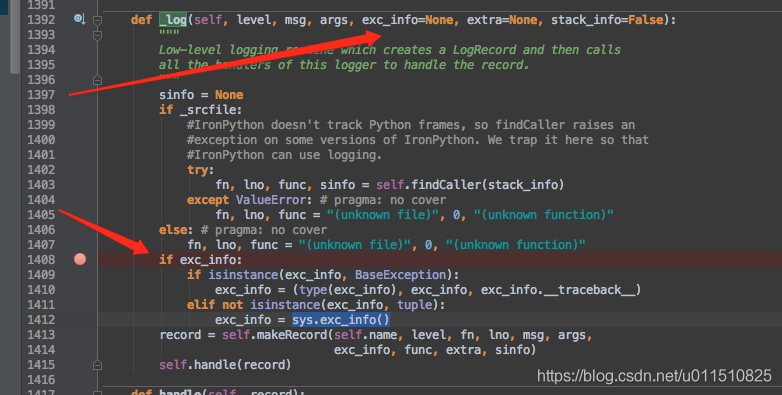python日志模块
一、logging模块
Python中有一个模块logging,可以直接记录日志
# 日志级别
# CRITICAL 50
# ERROR 40
# WARNING 30
# INFO 20
# DEBUG 10
logging.basicConfig()函数中的具体参数:
filename: 指定的文件名创建FiledHandler,这样日志会被存储在指定的文件中;
filemode: 文件打开方式,在指定了filename时使用这个参数,默认值为“w”还可指定为“a”;
format: 指定handler使用的日志显示格式;
datefmt: 指定日期时间格式。,格式参考strftime时间格式化(下文)
level: 设置rootlogger的日志级别
stream: 用指定的stream创建StreamHandler。可以指定输出到sys.stderr,sys.stdout或者文件,默认为sys.stderr。
若同时列出了filename和stream两个参数,则stream参数会被忽略。
format参数中可能用到的格式化信息:
| %(name)s | Logger的名字 |
| %(levelno)s | 数字形式的日志级别 |
| %(levelname)s | 文本形式的日志级别 |
| %(pathname)s | 调用日志输出函数的模块的完整路径名,可能没有 |
| %(filename)s | 调用日志输出函数的模块的文件名 |
| %(module)s | 调用日志输出函数的模块名 |
| %(funcName)s | 调用日志输出函数的函数名 |
| %(lineno)d | 调用日志输出函数的语句所在的代码行 |
| %(created)f | 当前时间,用UNIX标准的表示时间的浮 点数表示 |
| %(relativeCreated)d | 输出日志信息时的,自Logger创建以 来的毫秒数 |
| %(asctime)s | 字符串形式的当前时间。默认格式是 “2003-07-08 16:49:45,896”。逗号后面的是毫秒 |
| %(thread)d | 线程ID。可能没有 |
| %(threadName)s | 线程名。可能没有 |
| %(process)d | 进程ID。可能没有 |
| %(message)s | 用户输出的消息 |
二、logging模块测试
1、打印日志到标准输出中
import logging
import os
logging.basicConfig(filename=os.path.join(os.getcwd(),'log.txt'),level=logging.DEBUG)
logging.debug('debug message')
logging.info('info message')
logging.warning('warning message')
输出结果
C:\Users\Administrator\AppData\Local\Programs\Python\Python36\python.exe D:/pyworkpeace/tupian.py 'https://www.tianyancha.com/login'
WARNING:root:warning message
Process finished with exit code 0
可以看出默认情况下Python的logging模块将日志打印到了标准输出中,且只显示了大于等于WARNING级别的日志。默认的日志的格式为:
日志级别:Logger名称:用户输出消息
2、将日志文件输入到文件中
import os
logging.basicConfig(filename=os.path.join(os.getcwd(),'log.txt'),level=logging.DEBUG)
logging.debug('this is a message')
运行这三行代码后会在安装Python的目录中出现一个log.txt文件,文件内容
DEBUG:root:this is a message
DEBUG:root:debug message
3、自定义格式,输出日志文件

# -*-coding:utf-8-*-
import logging
def console_out(logFilename):
''''' Output log to file and console '''
# Define a Handler and set a format which output to file
logging.basicConfig(
level=logging.DEBUG, # 定义输出到文件的log级别,大于此级别的都被输出
format='%(asctime)s %(filename)s : %(levelname)s %(message)s', # 定义输出log的格式
datefmt='%Y-%m-%d %A %H:%M:%S', # 时间
filename=logFilename, # log文件名
filemode='w') # 写入模式“w”或“a”
# Define a Handler and set a format which output to console
console = logging.StreamHandler() # 定义console handler
console.setLevel(logging.INFO) # 定义该handler级别
formatter = logging.Formatter('%(asctime)s %(filename)s : %(levelname)s %(message)s') # 定义该handler格式
console.setFormatter(formatter)
# Create an instance
logging.getLogger().addHandler(console) # 实例化添加handler
# Print information # 输出日志级别
logging.debug('logger debug message')
logging.info('logger info message')
logging.warning('logger warning message')
logging.error('logger error message')
logging.critical('logger critical message')
if __name__ == "__main__":
console_out('logging.log')

输出结果:
此时也会自动生成一个日志文件,日志文件和运行文件在同一个文件夹中,文件名logging.log
2017-10-23 Monday 11:37:59 hgghf : DEBUG logger debug message
2017-10-23 Monday 11:37:59 hgghf : INFO logger info message
2017-10-23 Monday 11:37:59 hgghf : WARNING logger warning message
2017-10-23 Monday 11:37:59 hgghf : ERROR logger error message
2017-10-23 Monday 11:37:59 hgghf : CRITICAL logger critical message
修改输出路径:
filename='/tmp/test1.log', # log文件名
当将脚本中这行代码换一下,那么我们输出日志的路径地址就换成了D:\tmp
下面的方式同样可以达到上述结果
4、自定义输出位置

import logging
logging.basicConfig(level=logging.DEBUG,
format='%(asctime)s %(filename)s[line:%(lineno)d] %(levelname)s %(message)s',
datefmt='%a, %d %b %Y %H:%M:%S',
filename='/tmp/test.log',
filemode='w')
logging.debug('debug message')
logging.info('info message')
logging.warning('warning message')
logging.error('error message')
logging.critical('critical message')

由于运行脚本放在D:\pyworkpeace\下,输出文件在D盘tmp文件夹下test.log,内容如下:
Mon, 23 Oct 2017 15:00:05 tupian.py[line:11] DEBUG debug message
Mon, 23 Oct 2017 15:00:05 tupian.py[line:12] INFO info message
Mon, 23 Oct 2017 15:00:05 tupian.py[line:13] WARNING warning message
Mon, 23 Oct 2017 15:00:05 tupian.py[line:14] ERROR error message
Mon, 23 Oct 2017 15:00:05 tupian.py[line:15] CRITICAL critical message
三、Logger,Handler,Formatter,Filter的概念
原文:https://www.cnblogs.com/bethansy/p/7716747.html
如何优雅的记录日志
工作3年,解决线上问题无数。日志对于定位和分析问题的重要行不言而喻。那么python怎么优雅的记录日志呢
首先,python记录日志,首选是logging模块,没有啥争议。
日志的一般写法是这样的:
logging.info('info message')
logging.error('error message')这种日志一般作用不大,只能定位到程序正常执行时执行到哪一步和打印输出一些信息。对于一些异常之列的信息,我们需要使用try:execpt获取。
很多人是这样记录异常日志的:
>>> def test(a):
... int(a)
>>> try:
... test("a")
... except Exception as e:
... print(e.message)
...
invalid literal for int() with base 10: 'a'开发人员只看到一行python的报错,是很难定位问题的。我们需要错误的堆栈信息,定位到错误的源头,例如:
>>> try:
... test("a")
... except Exception as e:
... logging.exception(e)
...
ERROR:root:invalid literal for int() with base 10: 'a'
Traceback (most recent call last):
File "<stdin>", line 2, in <module>
File "<stdin>", line 2, in test
ValueError: invalid literal for int() with base 10: 'a'使用logging.exception 的话就可以拿到堆栈信息。是不是很神奇,我们一起来看看logging的源码,看它为啥能拿到堆栈信息。

对比error

发现,exception其实是调用error的,唯一的不同时,有一个默认参数exc_info=True。。。一直查看它的调用关系,到了这里:

看到这里,应该都清楚了,其实他使用的是sys.exc_info(),这个python内置sys函数。。。
明白了logging.exception的原理后,我们就可以这样定义日志了:
>>> try:
... test("a")
... except Exception as e:
... logging.error("执行test函数报错", exc_info=True)
...
ERROR:root:执行test函数报错
Traceback (most recent call last):
File "<stdin>", line 2, in <module>
File "<stdin>", line 2, in test
ValueError: invalid literal for int() with base 10: 'a'这样,不仅可以自定义logging,还可以打印堆栈信息。info同理,只要把error改成info即可
原文:https://blog.csdn.net/u011510825/article/details/83929151




















 1241
1241











 被折叠的 条评论
为什么被折叠?
被折叠的 条评论
为什么被折叠?








